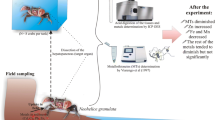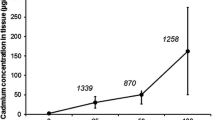Abstract
The aim of this study was to identify the involvement of metallothionein (MT) in Zn accumulation and elimination strategies in different tissues (gills, digestive gland, and remaining tissues) of Ruditapes decussatus. Clams were exposed to two Zn concentrations (100 and 1000 μg/L) for 40 days, followed by a depuration period of 50 days. The accumulation and elimination processes were complemented by subcellular Zn distribution, to determine the affinity of this element for the different cellular partitions. Subsequently, the involvement of MT was followed. Zinc concentrations in the tissues of R. decussatus exposed to 100 μg/L was partially regulated, whereas in those exposed to 1000 μg/L, Zn was accumulated (exponentially and linearly) throughout the exposure period. The greatest amount of Zn is associated to the insoluble fraction; however, in the highest Zn exposure, ∼30% is in the thermostable fraction, where MT occurs. Gel filtration chromatography confirmed that the Zn ions accumulated in this fraction were bound to MT. This protein is actively involved in the elimination of this metal, through the rapid degradation of the Zn–MT complex because MT and Zn are turning over simultaneously. Therefore, MT participates in Zn homeostasis in R. decussatus when Zn exposure is low. When Zn accumulation increases, the role of this protein changes from a constitutive function to the detoxification of the excess of Zn ions.





Similar content being viewed by others
References
Amiard JC, Amiard-Triquet C, Berthet B, Métayer C (1987) Comparative study of the patterns of bioaccumulation of essential (Cu, Zn) and non-essential (Cd, Pb) trace metals in various estuarine and coastal organisms. J Exp Mar Biol Ecol 106:73–89
Anandraj A, Marshall DJ, Gregory MA, McClurg TP (2002) Metal accumulation, filtration and O2 uptake rates in the mussel Perna perna (Mollusca: Bivalvia) exposed to Hg+, Cu2+ and Zn2+. Comp Biochem Physiol C: Toxicol Pharmacol 132(3):355–363
Ballatori N (2002) Transport of toxic metals by molecular mimicry. Environ Health Perspect 110(5):686–694
Baudrimont M, Andrès S, Durrieu G, Boudou A (2003) The key role of metallothionein in the bivalve Corbicula fluminea during the depuration phase, after in situ exposure to Cd and Zn. Aquat Toxicol 63(2):89–102
Bebianno MJ, Langston WJ (1989) Quantification of metallothioneins in marine invertebrates using differential pulse polarography. Port Electrochim Acta 7:59–64
Bebianno MJ, Serafim MA (2003) Variation of metal and metallothionein concentrations in a natural population of Ruditapes decussatus. Arch Environ Contam Toxicol 44:53–66
Bebianno MJ, Nott JA, Langston WJ (1993) Cadmium metabolism in the clam Ruditapes decussata: the role of metallothioneins. Aquat Toxicol 27:315–334
Bragigand V, Berthet B (2003) Some methodological aspects of metallothionein evaluation. Comp Biochem Physiol 134A:55–61
Brown MT, Depledge MH (1998) Determinants of trace metal concentrations in marine organisms In: Langston WJ, Bebianno MJ (eds) Metal metabolism in aquatic environments. Chapman & Hall, London
Brzóska MM, Moniuszko-Jakoniuk J (2001) Interactions between cadmium and zinc in the organism. Food Chem Toxicol 39:967–980
Castro L, Carmo C, Peres I, Pihan JC (1996) The clam, Ruditapes decussatus L., as a pollution bioindicator: zinc and lead accumulation and depuration. Ecology 27(4):263–268
Chan HM (1988) Accumulation and tolerance to cadmium, copper, lead and zinc by the green mussel Perna viridis. Mar Ecol Prog Ser 48:295–303
Chong K, Wang W-X (2001) Comparative studies on the biokinetics of Cd, Cr, and Zn in the green mussel Perna viridis and the Manila clam Ruditapes philippinarum. Environ Pollut 115(1):107–121
Couillard Y, Campbell PJC, Tessier A (1993) Response of metallothionein concentrations in a freshwater bivalve (Anodonta grandis) along as environmental cadmium gradient. Limnol Oceanogr 38:299–313
Geffard A, Amiard JC, Amiard-Triquet C (2002) Kinetics of metal elimination in oysters from a contaminated estuary. Comp Biochem Physiol 131C:281–293
George SG, Olsson PE (1994) Metallothionein as indicator of trace pollution. In: Kramer KJM (ed) Biological monitoring of coastal waters and estuaries. CRC Press, Boca Raton, FL
George SG, Pirie BJS (1980) Metabolism of zinc in the mussel Mytilus edulis (L.): a combined ultrastructural and biochemical study. J Mar Biolog Assoc UK 60:575–590
Géret F, Jouan A, Turpin V, Bebianno MJ, Cosson RP (2002) Influence of metal exposure on metallothionein synthesis and lipid peroxidation in two bivalve mollusks: the oyster (Crassostrea gigas) and the mussel (Mytilus edulis). Aquat Living Resour 15(1):61–66
Hamza-Chaffai A, Amiard JC, Cosson RP (1999) Relationship between metallothioneins and metals in a natural population of the clam Ruditapes decussatus from Sfax coast: a non-linear model using Box-Cox transformation. Comp Biochem Physiol 123C:153–163
Hamza-Chaffai A, Amiard JC, Pellerin J, Joux L, Berthet B (2000) The potential use of metallothionein in the clam Ruditapes decussatus as a biomarker of in situ metal exposure. Comp Biochem Physiol 127C:185–197
Johansson C, Cain DJ, Luoma SN (1986) Variability in the fractionation of Cu, Ag, and Zn among cytosolic proteins in the bivalve Macoma balthica. Mar Ecol Prog Ser 28:87–97
Langston WJ, Bebianno MJ, Burt GR (1998) Metal handling strategies in molluscs. In: Langston WJ, Bebianno MJ (eds) Metal metabolism in aquatic environments, Chapman & Hall, London
Maret W, Vallée BL (1998) Thiolate ligands in metallothionein confer redox activity on zinc clusters. Proc Natl Acad Sci USA 95:3478–3482
Mason AZ, Nott JA (1980) A rapid, routine technique for the X-ray microanalysis of microincinerated cryosections: a SEM study of inorganic deposits in tissues of the marine gastropod Littorina littorea L. J Histochem Cytochem 28:1301–1311
Nott JA, Nicolaidou A (1993) Bioreduction of zinc and manganese along a molluscan food chain. Comp Biochem Physiol 104:235–238
Okazaki RK, Panietz MH (1981) Depuration of twelve trace metals in tissues of oysters Crassostrea gigas and Crassostrea virginica. Mar Biol 63:113–120
Otvos JD, Olafson RW, Armitage IM (1982) Structure of an invertebrate metallothionein from Scylla serrata. J Biol Chem 357(5):2427–2431
Phillips DJH (1985) Organochlorines and trace metals in green-lipped mussels Perna viridis from Hong Kong waters: a test of indicator ability. Mar Ecol Prog Ser 21:251–258
Phillips DJH, Rainbow PS (1988) Barnacles and mussels as biomonitors of trace elements: a comparative study. Mar Ecol Prog Ser 49:83–93
Phillips D, Rainbow P (1993) Biomonitoring of trace aquatic contaminants. Elsevier Applied Science, London
Prasad AS (1993) Essentiality and toxicity of zinc. Scand J Work Environ Health 19(1):134–136
Rainbow PS (1995) Biomonitoring of heavy metal availability in the marine environment. Mar Pollut Bull 31(4–12):183–192
Raspor B, Pavicic J (1991) Induction of metallothionein-like proteins in the digestive gland of Mytilus galloprovincialis after a chronic exposure to mixture of trace heavy metals. Chem Speciation Bioavail 3(2):39–46
Regoli F, Orlando E (1994) Seasonal variation of trace metal concentrations (Cu, Fe, Mn, Pb, Zn) in the digestive gland of the Mediterranean mussel Mytilus galloprovincialis: comparison between a polluted and non polluted site. Arch Environ Contam Toxicol 27:36–43
Roesijadi G (1980) Influence of copper on the clam Protothaca staminea: effects on gills and occurrence of copper-binding proteins. Biol Bull 158(2):233–247
Roesijadi G (1994a) Behaviour of metallothionein-bound metals in a natural population of estuarine mollusc. Mar Environ Res 38:147–168
Roesijadi G (1994b) Metallothionein induction as a measure of response to metal exposure in aquatic animals. Environ Health Perspect 102(12):91–96
Roesijadi G, Unger ME, Morris JE (1988) Immunochemical quantification of metallothioneins of a marine mollusc. Can J Fish Aquat Sci 45:1257–1263
Roméo M, Gnassia-Barelli M (1995) Metal distribution in different tissues and in subcellular fractions of the Mediterranean clam Ruditapes decussatus treated with cadmium, copper and zinc. J Comp Physiol 111C(3):457–463
Serafim MA, Bebianno MJ (2001) Variation of metallothionein and metal concentrations in the digestive gland of the clam Ruditapes decussatus: sex and seasonal effects. Environ Toxicol Chem 20(3):544–552
Simes DC, Bebianno MJ, Moura JJ (2003) Isolation and characterisation of metallothionein from the clam Ruditapes decussatus. Aquat Toxicol 63(3):307–318
Udom AO, Brady FO (1980) Reactivation in vitro of zinc-requiring apo-enzymes by rat liver zinc-thionein. Biochem J 187(2):329–335
Vallée BL, Auld DS (1990) Zinc coordination, function, and structure of zinc enzymes and other proteins. Biochemistry 29:5647–5649
Vallée BL, Falchuk KH (1993) The biochemical basis of zinc physiology. Physiol Rev 73:79–118
Viarengo A, Nott JA (1993) Mechanisms of heavy metal cation homeostasis in marine invertebrates. Comp Biochem Physiol 104C(3):355–372
Viarengo A, Pertica M, Canesi L, Mazzucotelli A, Orunesu M, Bouquegneau JM (1989) Purification and biochemical characterization of a lysosomal copper-rich thionein-like protein involved in metal detoxification in the digestive gland of mussels. Comp Biochem Physiol 93C:389–395
Wallner-Kersanach M, Theede H, Eversberg U, Lobo S (2000) Accumulation and elimination of trace metals in a transplantation experiment with Crassostrea rhizophorae. Arch Environ Contam Toxicol 38:40–45
Acknowledgment
Angela Serafim was supported by a Portuguese Foundation of Science and Technology grant (CIÊNCIA/BD/2541/93).
Author information
Authors and Affiliations
Corresponding author
Rights and permissions
About this article
Cite this article
Serafim, A., Bebianno, M. Involvement of Metallothionein in Zn Accumulation and Elimination Strategies in Ruditapes decussatus . Arch Environ Contam Toxicol 52, 189–199 (2007). https://doi.org/10.1007/s00244-005-0258-6
Received:
Accepted:
Published:
Issue Date:
DOI: https://doi.org/10.1007/s00244-005-0258-6




